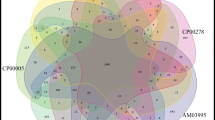Abstract
An oligonucleotide primer pair set based on internal transcribed spacer regions of rDNA for PCR, which gives the amplicon for only the DNA from Sclerotium hydrophilum was designed. Tests on the specificity of the primers concerned showed that a single product of 540 bp was amplified from the DNA of S. hydrophilum but not from the DNA of any other species responsible for sheath disease in rice, suggesting that the primer pair could be used to develop a PCR-based diagnostic method to provide a rapid and accurate molecular detection of this pathogen in rice leaf sheath.
Similar content being viewed by others
References
Banniza S, Sy AA, Bridge PD (1999) Characterization of populations of Rhizoctonia solani in paddy rice fields in Cete d’Ivoire. Phytopathology 89, 414–420. doi: 10.1094/PHYTO.1999.89.5.414
Cedeno L, Nass H, Carrero C, Cardona R, Rodriguez H, Aleman L (1997) Sclerotium hydrophilum en arroz en Venezuela. Fitopatologia Venezolana 10, 9–12.
Inagaki K (2001) Outbreak of rice Sclerotium diseases in paddy fields and physiological and ecological characteristics of these causal fungi. Scientific Reports of the Faculty of Agriculture, Meijo University 37, 57–66.
Ippolito A, Schena L, Nigro F (2002) Detection of Phytophthora nicotianae and P. citrophthora in citrus roots and soils by nested PCR. European Journal of Plant Pathology 108, 855–868. doi: 10.1023/A:1021208106857
Johanson A, Turner HC, McKay GJ, Brown AE (1998) A PCR based method to distinguish fungi of the rice sheath-blight complex, Rhizoctonia solani, R. oryzae and R. oryzae-sativae. FEMS Microbiology Letters 162, 289–294.
Lanoiselet VM, Cother EJ, Ash GJ, Harper JDI (2002) First report of Sclerotium hydrophilum on leaf sheath of rice (Oryza sativa) in south-eastern Australia. Plant Pathology 51, 813. doi: 10.1046/j.1365-3059.2002.00783.x
Lee SB, Taylor JW (1990) Isolation of DNA from fungal mycelia and single spores. In ‘PCR protocols: a guide to methods and applications’. (Eds MA Innis, DH Gelfand, JJ Sninsky, TJ White) pp. 282–287. (Academic Press: San Diego, CA)
Linde CC, Zala M, David Paulraj RS, McDonald BA, Gnanamanickam SS (2005) Population structure of the rice sheath blight pathogen Rhizoctonia solani AG-1 IA from India. European Journal of Plant Pathology 112, 113–121. doi: 10.1007/s10658-005-1753-3
Lübeck M, Poulsen H (2001) UP-PCR blot hybridization as a tool for identification of anastomosis groups in the Rhizoctonia solani complex. FEMS Microbiology Letters 201, 83–89.
Mazzola M, Wong OT, Cook RJ (1996) Virulence of Rhizoctonia oryzae and R. solani AG-8 on wheat and detection of R. oryzae in plant tissue by PCR. Phytopathology 86, 354–360. doi: 10.1094/Phyto-86-354
Neeraja CN, Shenoy VV, Reddy CS, Sarma RP (2003) Isozyme polymorphism and virulence of Indian isolates of the rice sheath blight fungus. Mycopathologia 156, 101–108. doi: 10.1023/A:1022988710654
Pethybridge SJ, Scott JB, Hay FS (2004) Genetic relationships among isolates of Phoma ligulicola from pyrethrum and chrysanthemum based on ITS sequences and its detection by PCR. Australasian Plant Pathology 33, 173–181. doi: 10.1071/AP03097
Rosewich UL, Pettway RE, McDonald BA, Kistler HC (1999) High levels of gene flow and heterozygote excess characterize Rhizoctonia solani AG-1 IA (Thanatephorus cucumeris) from Texas. Fungal Genetics and Biology 28, 148–159. doi: 10.1006/fgbi.1999.1174
Ruan XY, Chen XQ (2002) A report on the pathogenic identification of rice globular sclerotial disease from Yunnan Province. Journal of Yunnan Agricultural University 17, 126–129.
White TJ, Bruns T, Lee S, Taylor J (1990) Amplification and direct sequencing of fungal ribosomal RNA genes for phylogenetics. In ‘PCR protocols: a guide to methods and applications’. (Eds MA Innis, DH Gelfand, JJ Sninsky, TJ White) pp. 315–322. (Academic Press: San Diego, CA)
Zhang ZG, Chen RH, Wang YC, Wang KR, Zheng XB (2005) Molecular detection of Verticillium albo-atrum by PCR based on its sequences. Agricultural Sciences in China 4, 760–766.
Author information
Authors and Affiliations
Corresponding author
Rights and permissions
About this article
Cite this article
Hu, C.J., Li, Y.R., Wei, Y.W. et al. A PCR-based method to detect Sclerotium hydrophilum in infected rice leaf sheaths. Australasian Plant Pathology 37, 40–42 (2008). https://doi.org/10.1071/AP07076
Received:
Accepted:
Issue Date:
DOI: https://doi.org/10.1071/AP07076




